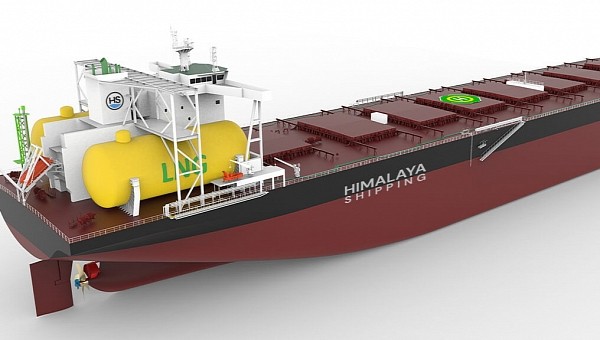It seems impossible even to this day, but 100% green fleets could revolutionize shipping in the future. Maritime transportation is being decarbonized in small, painful steps. It takes a lot of research and it’s not cheap to switch to lower-emission alternatives for carrying cargo across oceans. But one of the solutions that seems to be ahead of the others is LNG.
Liquefied natural gas (LNG) is precisely that: a gas found naturally in some parts of the world, which is reduced to a liquid form, through a cooling process. According to UK’s National Grid, it’s considered a traditional source of energy that’s been used for heating and transport. It’s not exactly a green alternative, because it is a fossil fuel, but at least it’s the cleanest of them.
LNG’s CO2 emissions are 40% lower compared to coal, and 30% lower compared to oil. Another advantage is that it doesn’t emit soot or particulates which release toxic elements into the air. Mostly composed of methane (up to 95%) LNG can be seen as the answer to what the National Grid defines as “the energy trilemma,” referring to affordability, security, and lowered emissions.
This makes LNG one of the best solutions for transitioning to net zero. In other words, it’s not green, but it’s taking us there. In recent years, it has seen a tremendous growth in the maritime sector. If you’ve been with us for some time, you have most likely learned about pioneering vessels such as the Sunflower Kurenai, the AIDACosma, or Aurora Botnia. What all of these have in common is –you’ve guessed it- LNG.
The Sunflower Kurenai is the first LNG-fueled ferry launched by the MOL Group, one of the largest shipping companies in the world. The AIDAcosma is German cruise line AIDA’s second ship to run on this low-emission fuel. Wasaline’s Aurora Botnia, a dual-fuel passenger and car ferry claims to be the greenest in its class.
Now, Himalaya Shipping is also ready to join this “exclusive” club. This independent bulk carrier company incorporated in Bermuda is ready to make a change in the industry, by providing lower-emissions shipping. To do so, its future fleet will be comprised entirely of dual-fuel ships with an eco-friendly design and LNG-based propulsion.
The Newcastlemax carriers are currently being built by the New Times shipyard in China, and are meant to comply with IMO (International Maritime Organization) standards for 2030 and beyond.
The company recently announced that a “major” Japanese company became a customer, agreeing to charter one of these LNG-fueled ships for two years. Once the first carrier is ready to leave the Chinese shipyard, it will be ready for charter operations costing $30,000 per day.
According to Herman Billung, contracted CEO of Himalaya Shipping, this proves “Himalaya Shipping’s low-emission fleet meeting all expected regulations in the foreseeable future.” Plus, since LNG is only a temporary solution, these dry bulk carriers of the future are also designed to be compatible with next-generation fuels.
LNG’s CO2 emissions are 40% lower compared to coal, and 30% lower compared to oil. Another advantage is that it doesn’t emit soot or particulates which release toxic elements into the air. Mostly composed of methane (up to 95%) LNG can be seen as the answer to what the National Grid defines as “the energy trilemma,” referring to affordability, security, and lowered emissions.
This makes LNG one of the best solutions for transitioning to net zero. In other words, it’s not green, but it’s taking us there. In recent years, it has seen a tremendous growth in the maritime sector. If you’ve been with us for some time, you have most likely learned about pioneering vessels such as the Sunflower Kurenai, the AIDACosma, or Aurora Botnia. What all of these have in common is –you’ve guessed it- LNG.
The Sunflower Kurenai is the first LNG-fueled ferry launched by the MOL Group, one of the largest shipping companies in the world. The AIDAcosma is German cruise line AIDA’s second ship to run on this low-emission fuel. Wasaline’s Aurora Botnia, a dual-fuel passenger and car ferry claims to be the greenest in its class.
Now, Himalaya Shipping is also ready to join this “exclusive” club. This independent bulk carrier company incorporated in Bermuda is ready to make a change in the industry, by providing lower-emissions shipping. To do so, its future fleet will be comprised entirely of dual-fuel ships with an eco-friendly design and LNG-based propulsion.
The Newcastlemax carriers are currently being built by the New Times shipyard in China, and are meant to comply with IMO (International Maritime Organization) standards for 2030 and beyond.
The company recently announced that a “major” Japanese company became a customer, agreeing to charter one of these LNG-fueled ships for two years. Once the first carrier is ready to leave the Chinese shipyard, it will be ready for charter operations costing $30,000 per day.
According to Herman Billung, contracted CEO of Himalaya Shipping, this proves “Himalaya Shipping’s low-emission fleet meeting all expected regulations in the foreseeable future.” Plus, since LNG is only a temporary solution, these dry bulk carriers of the future are also designed to be compatible with next-generation fuels.






